instrument panel HONDA CIVIC COUPE 2016 10.G Quick Guide
[x] Cancel search | Manufacturer: HONDA, Model Year: 2016, Model line: CIVIC COUPE, Model: HONDA CIVIC COUPE 2016 10.GPages: 82, PDF Size: 5.2 MB
Page 3 of 82
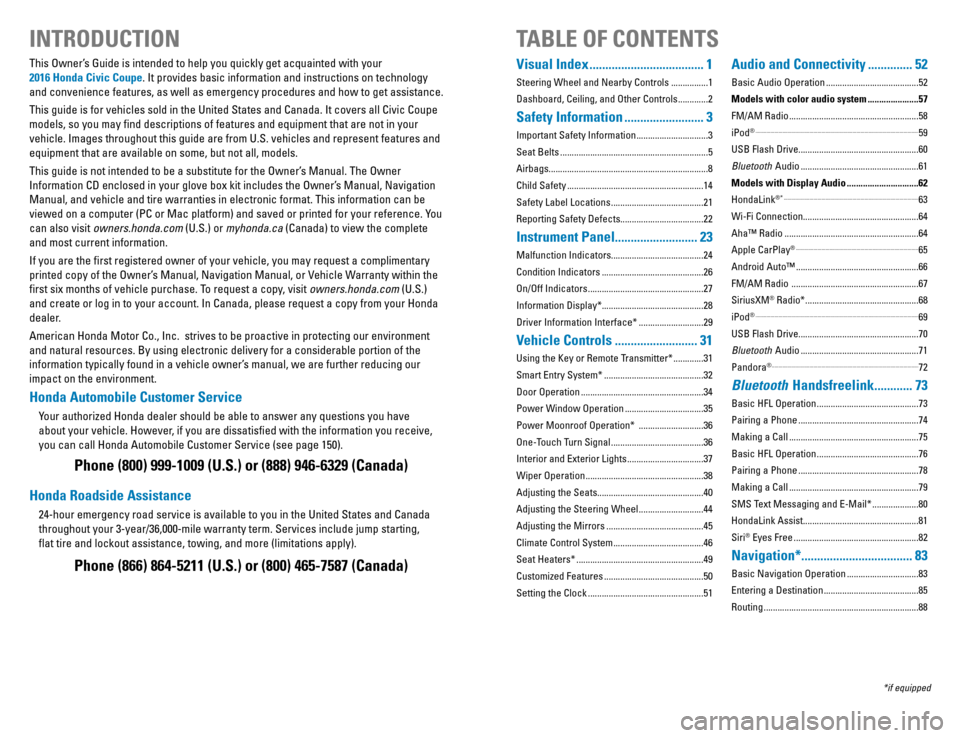
INTRODUCTION TABLE OF CONTENTS
This Owner’s Guide is intended to help you quickly get acquainted with your
2016 Honda Civic Coupe. It provides basic information and instructions on technology
and convenience features, as well as emergency procedures and how to get assistance.
This guide is for vehicles sold in the United States and Canada. It covers all Civic Coupe models, so you may �nd descriptions of features and equipment that are not in your
vehicle. Images throughout this guide are from U.S. vehicles and represent features and equipment that are available on some, but not all, models.
This guide is not intended to be a substitute for the Owner’s Manual. The Owner
Information CD enclosed in your glove box kit includes the Owner’s Manual, Navigation
Manual, and vehicle and tire warranties in electronic format. This information can be
viewed on a computer (PC or Mac platform) and saved or printed for your reference. You can also visit owners.honda.com (U.S.) or myhonda.ca (Canada) to view the complete
and most current information.
If you are the �rst registered owner of your vehicle, you may request a complimentary
printed copy of the Owner’s Manual, Navigation Manual, or Vehicle Warranty within the
�rst six months of vehicle purchase. To request a copy, visit owners.honda.com (U.S.)
and create or log in to your account. In Canada, please request a copy from your Honda
dealer. American Honda Motor Co., Inc. strives to be proactive in protecting our environment
and natural resources. By using electronic delivery for a considerable portion of the
information typically found in a vehicle owner’s manual, we are further reducing our impact on the environment.
Honda Automobile Customer Service
Your authorized Honda dealer should be able to answer any questions you have
about your vehicle. However, if you are dissatis�ed with the information you receive, you can call Honda Automobile Customer Service (see page 150).
Phone (800) 999-1009 (U.S.) or (888) 946-6329 (Canada)
Honda Roadside Assistance
24-hour emergency road service is available to you in the United States and Canada
throughout your 3-year/36,000-mile warranty term. Services include jump starting, �at tire and lockout assistance, towing, and more (limitations apply).
Phone (866) 864-5211 (U.S.) or (800) 465-7587 (Canada)
*if equipped
Visual Index .................................... 1
Steering Wheel and Nearby Controls ................1
Dashboard, Ceiling, and Other Controls .............2
Safety Information .........................3
Important Safety Information ...............................3
Seat Belts ................................................................ 5
Airbags.....................................................................8 Child Safety ........................................................... 14
Safety Label Locations ........................................21
Reporting Safety Defects....................................22
Instrument Panel.......................... 23
Malfunction Indicators........................................24 Condition Indicators ............................................ 26
On/Off Indicators .................................................. 27
Information Display*............................................28Driver Information Interface* ............................29
Vehicle Controls ..........................31
Using the Key or Remote Transmitter* .............31
Smart Entry System* ........................................... 32
Door Operation ..................................................... 34
Power Window Operation ..................................35
Power Moonroof Operation* ............................36
One-Touch Turn Signal ........................................36
Interior and Exterior Lights .................................37
Wiper Operation ................................................... 38
Adjusting the Seats..............................................40 Adjusting the Steering Wheel ............................44
Adjusting the Mirrors .......................................... 45
Climate Control System .......................................46
Seat Heaters* ....................................................... 49
Customized Features ........................................... 50
Setting the Clock .................................................. 51
Audio and Connectivity ..............52
Basic Audio Operation ........................................52
Models with color audio system ......................57
FM/AM Radio ........................................................ 58
iPod ®
.........................................................................................................................
59
USB Flash Drive....................................................60 Bluetooth Audio ................................................... 61
Models with Display Audio ...............................62
HondaLink ®*
....................................................................................................
63
Wi-Fi Connection..................................................64Aha™ Radio .......................................................... 64
Apple CarPlay ®
...........................................................................................
65
Android Auto™ ..................................................... 66
FM/AM Radio ....................................................... 67
SiriusXM ®
Radio* ................................................. 68
iPod ®
.........................................................................................................................
69
USB Flash Drive....................................................70Bluetooth Audio ................................................... 71
Pandora ®
.............................................................................................................
72
Bluetooth Handsfreelink ............73
Basic HFL Operation ............................................ 73
Pairing a Phone .................................................... 74
Making a Call ........................................................ 75
Basic HFL Operation ............................................ 76
Pairing a Phone .................................................... 78
Making a Call ........................................................ 79
SMS Text Messaging and E-Mail* ....................80
HondaLink Assist..................................................81 Siri ®
Eyes Free ...................................................... 82
Navigation*................................... 83
Basic Navigation Operation ...............................83
Entering a Destination ......................................... 85
Routing ................................................................... 88
Page 4 of 82
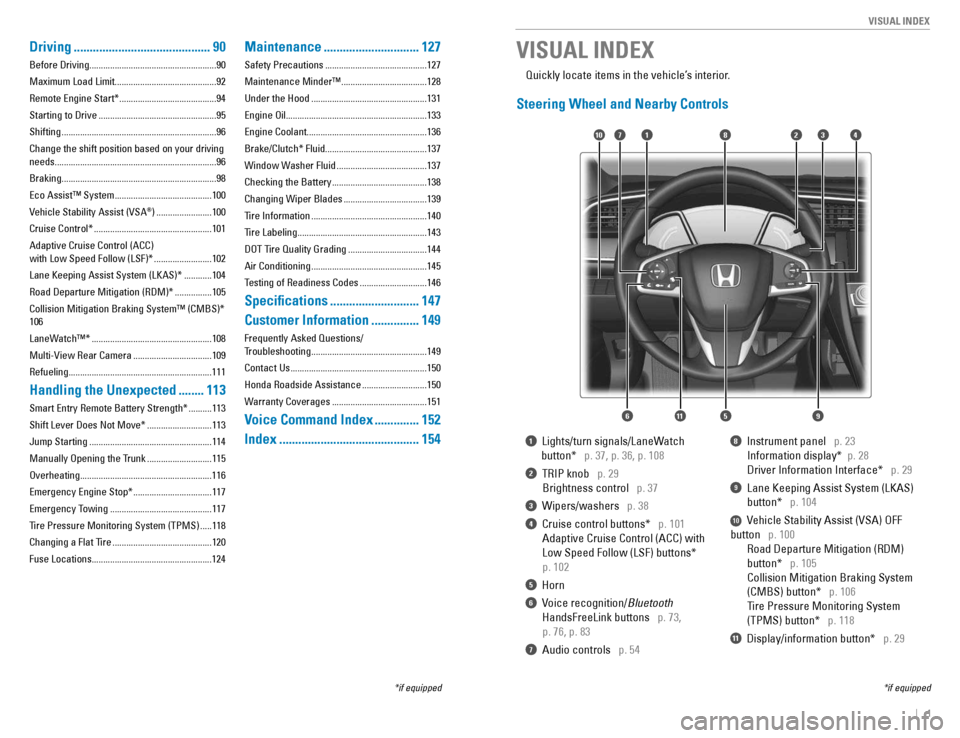
| 1
VISUAL INDEX
1 Lights/turn signals/LaneWatch
button*
p. 37, p. 36, p. 108
2 TRIP knob p. 29
Brightness control
p. 37
3 Wipers/washers p. 38
4 Cruise control buttons* p. 101
Adaptive Cruise Control (ACC) with
Low Speed Follow (LSF) buttons*
p. 102
5 Horn
6 Voice recognition/ Bluetooth
HandsFreeLink buttons
p. 73,
p. 76, p. 83
7 Audio controls p. 54
8 Instrument panel p. 23
Information display* p. 28
Driver Information Interface* p. 29
9 Lane Keeping Assist System (LKAS)
button*
p. 104
10 Vehicle Stability Assist (VSA) OFF
button
p. 100
Road Departure Mitigation (RDM)
button*
p. 105
Collision Mitigation Braking System
(CMBS) button*
p. 106
Tire Pressure Monitoring System
(TPMS) button*
p. 118
11 Display/information button* p. 29
VISUAL INDEX
*if equipped
*if equipped
Quickly locate items in the vehicle’s interior.
Steering Wheel and Nearby Controls
2
5
71310
6
48
911
Driving
........................................... 90
Before Driving.......................................................90
Maximum Load Limit............................................92Remote Engine Start* .......................................... 94
Starting to Drive ................................................... 95
Shifting ................................................................... 96
Change the shift position based on your driving
needs......................................................................96
Braking...................................................................98Eco Assist™ System .......................................... 100
Vehicle Stability Assist (VSA ®
) ........................ 100
Cruise Control* ................................................... 101
Adaptive Cruise Control (ACC) with Low Speed Follow (LSF)* .........................102
Lane Keeping Assist System (LKAS)* ............104
Road Departure Mitigation (RDM)* ................105
Collision Mitigation Braking System™ (CMBS)* 106
LaneWatch™* .................................................... 108
Multi-View Rear Camera ..................................109
Refueling..............................................................111
Handling the Unexpected ........113
Smart Entry Remote Battery Strength* ..........113
Shift Lever Does Not Move* ............................113
Jump Starting ..................................................... 114
Manually Opening the Trunk ............................115
Overheating.........................................................116 Emergency Engine Stop* ..................................117
Emergency Towing ............................................ 117
Tire Pressure Monitoring System (TPMS) .....118
Changing a Flat Tire ........................................... 120
Fuse Locations....................................................124
Maintenance .............................. 127
Safety Precautions ............................................ 127
Maintenance Minder™ .....................................128
Under the Hood .................................................. 131
Engine Oil.............................................................133
Engine Coolant....................................................136
Brake/Clutch* Fluid............................................137
Window Washer Fluid .......................................137
Checking the Battery ......................................... 138
Changing Wiper Blades ....................................139
Tire Information .................................................. 140
Tire Labeling ........................................................ 143
DOT Tire Quality Grading ..................................144
Air Conditioning .................................................. 145
Testing of Readiness Codes .............................146
Speci�cations ............................ 147
Customer Information ...............149
Frequently Asked Questions/
Troubleshooting .................................................. 149
Contact Us ........................................................... 150
Honda Roadside Assistance ............................150
Warranty Coverages ......................................... 151
Voice Command Index ..............152
Index ............................................ 154
Page 10 of 82
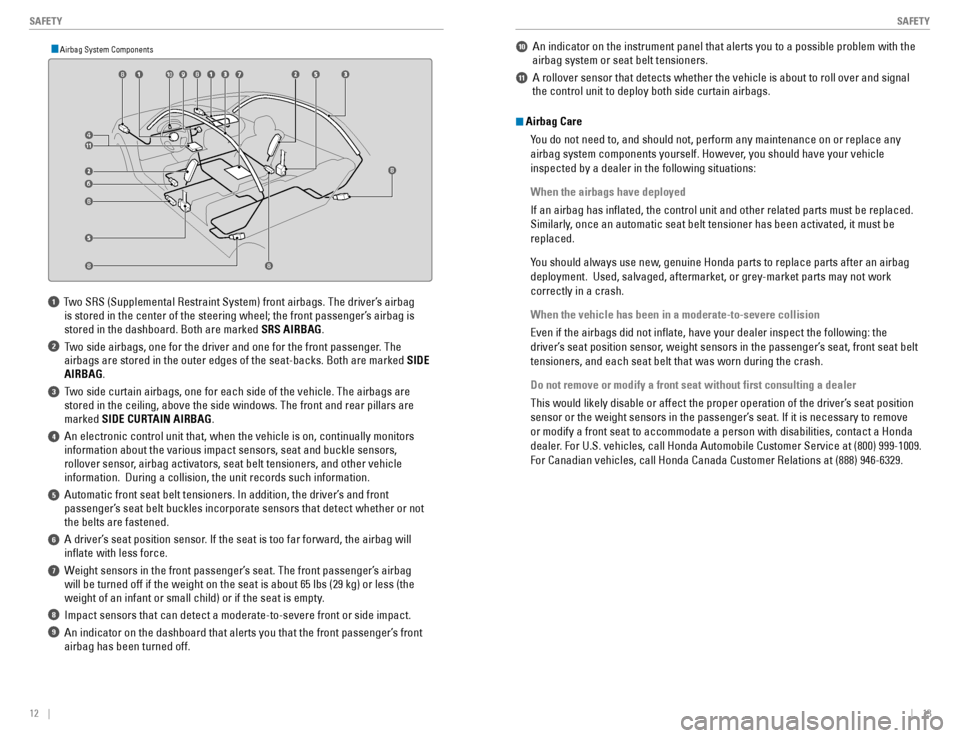
12 || 13
SAFETY
SAFETY
1 Two SRS (Supplemental Restraint System) front airbags. The driver’s airbag
is stored in the center of the steering wheel; the front passenger’s airbag is stored in the dashboard. Both are marked SRS AIRBAG.
2 Two side airbags, one for the driver and one for the front passenger. The
airbags are stored in the outer edges of the seat-backs. Both are marked SIDE
AIRBAG .
3 Two side curtain airbags, one for each side of the vehicle. The airbags are
stored in the ceiling, above the side windows. The front and rear pillars are marked SIDE CURTAIN AIRBAG .
4 An electronic control unit that, when the vehicle is on, continually monitors
information about the various impact sensors, seat and buckle sensors,
rollover sensor, airbag activators, seat belt tensioners, and other vehicle information. During a collision, the unit records such information.
5 Automatic front seat belt tensioners. In addition, the driver’s and front passenger’s seat belt buckles incorporate sensors that detect whether or not the belts are fastened.
6 A driver’s seat position sensor. If the seat is too far forward, the airbag will
in�ate with less force.
7 Weight sensors in the front passenger’s seat. The front passenger’s airbag will be turned off if the weight on the seat is about 65 lbs (29 kg) or less (the
weight of an infant or small child) or if the seat is empty.
8 Impact sensors that can detect a moderate-to-severe front or side impact.
9 An indicator on the dashboard that alerts you that the front passenger’s front airbag has been turned off.
Airbag System Components
Airbag Care
You do not need to, and should not, perform any maintenance on or replace any
airbag system components yourself. However, you should have your vehicle inspected by a dealer in the following situations:
When the airbags have deployed
If an airbag has in�ated, the control unit and other related parts must be replaced.
Similarly, once an automatic seat belt tensioner has been activated, it must be replaced.
You should always use new, genuine Honda parts to replace parts after an airbag
deployment. Used, salvaged, aftermarket, or grey-market parts may not work correctly in a crash.
When the vehicle has been in a moderate-to-severe collision
Even if the airbags did not in�ate, have your dealer inspect the following: the
driver’s seat position sensor, weight sensors in the passenger’s seat, front seat belt tensioners, and each seat belt that was worn during the crash.
Do not remove or modify a front seat without first consulting a dealer
This would likely disable or affect the proper operation of the driver’s seat position
sensor or the weight sensors in the passenger’s seat. If it is necessary to remove
or modify a front seat to accommodate a person with disabilities, contact a Honda
dealer. For U.S. vehicles, call Honda Automobile Customer Service at (800) 999-1009.
For Canadian vehicles, call Honda Canada Customer Relations at (888) 946-6329.
10 An indicator on the instrument panel that alerts you to a possible problem with the
airbag system or seat belt tensioners.
11 A rollover sensor that detects whether the vehicle is about to roll over and signal the control unit to deploy both side curtain airbags.
Page 15 of 82
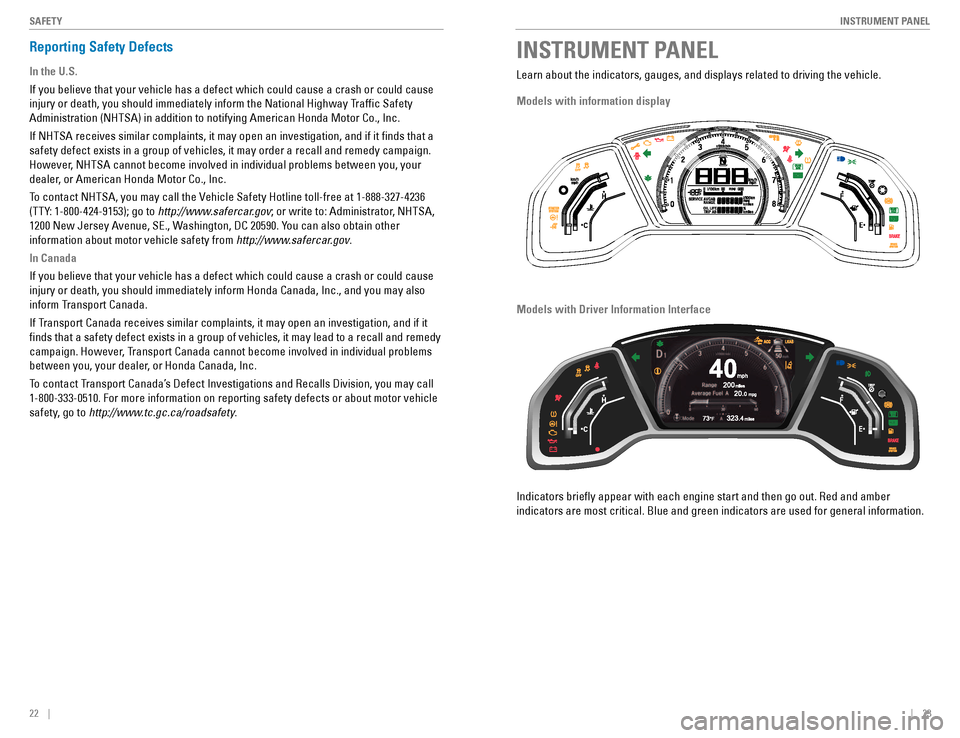
22 || 23
INSTRUMENT PANEL
SAFETY
INSTRUMENT PANELReporting Safety Defects
In the U.S.
If you believe that your vehicle has a defect which could cause a crash or could cause
injury or death, you should immediately inform the National Highway Traf�c Safety Administration (NHTSA) in addition to notifying American Honda Motor Co., Inc.
If NHTSA receives similar complaints, it may open an investigation, and if it �nds that a
safety defect exists in a group of vehicles, it may order a recall and remedy campaign.
However, NHTSA cannot become involved in individual problems between you, your
dealer, or American Honda Motor Co., Inc.
To contact NHTSA, you may call the Vehicle Safety Hotline toll-free at 1-888-327-4236
(TTY: 1-800-424-9153); go to http://www.safercar.gov; or write to: Administrator, NHTSA,
1200 New Jersey Avenue, SE., Washington, DC 20590. You can also obtain other information about motor vehicle safety from http://www.safercar.gov.
In Canada
If you believe that your vehicle has a defect which could cause a crash or could cause
injury or death, you should immediately inform Honda Canada, Inc., and you may also
inform Transport Canada.
If Transport Canada receives similar complaints, it may open an investigation, and if it
�nds that a safety defect exists in a group of vehicles, it may lead to a recall and remedy
campaign. However, Transport Canada cannot become involved in individual problems
between you, your dealer, or Honda Canada, Inc.
To contact Transport Canada’s Defect Investigations and Recalls Division, you may call
1-800-333-0510. For more information on reporting safety defects or about motor vehicle
safety, go to http://www.tc.gc.ca/roadsafety . Learn about the indicators, gauges, and displays related to driving the vehicle.
Models with information display
Indicators brie�y appear with each engine start and then go out. Red and amber indicators are most critical. Blue and green indicators are used for general information.
Models with Driver Information Interface
200
323.41234Menu40 80
Page 16 of 82
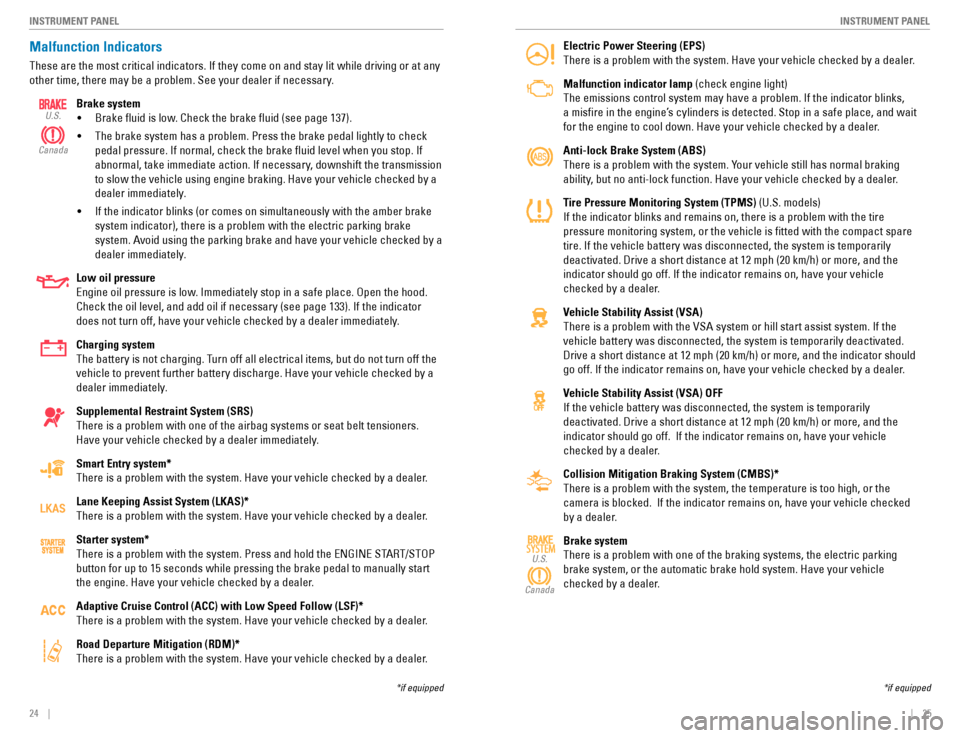
24 || 25
INSTRUMENT PANEL
INSTRUMENT PANEL
Electric Power Steering (EPS) There is a problem with the system. Have your vehicle checked by a dealer.
Malfunction indicator lamp (check engine light)
The emissions control system may have a problem. If the indicator blinks,
a mis�re in the engine’s cylinders is detected. Stop in a safe place, and wait
for the engine to cool down. Have your vehicle checked by a dealer. Anti-lock Brake System (ABS)
There is a problem with the system. Your vehicle still has normal braking
ability, but no anti-lock function. Have your vehicle checked by a dealer.
Tire Pressure Monitoring System (TPMS) (U.S. models)
If the indicator blinks and remains on, there is a problem with the tire
pressure monitoring system, or the vehicle is �tted with the compact spare tire. If the vehicle battery was disconnected, the system is temporarily deactivated. Drive a short distance at 12 mph (20 km/h) or more, and the indicator should go off. If the indicator remains on, have your vehicle
checked by a dealer.
Vehicle Stability Assist (VSA)
There is a problem with the VSA system or hill start assist system. If the
vehicle battery was disconnected, the system is temporarily deactivated. Drive a short distance at 12 mph (20 km/h) or more, and the indicator should
go off. If the indicator remains on, have your vehicle checked by a dealer.
Vehicle Stability Assist (VSA) OFF If the vehicle battery was disconnected, the system is temporarily deactivated. Drive a short distance at 12 mph (20 km/h) or more, and the indicator should go off. If the indicator remains on, have your vehicle
checked by a dealer. Collision Mitigation Braking System (CMBS)* There is a problem with the system, the temperature is too high, or the
camera is blocked. If the indicator remains on, have your vehicle checked
by a dealer. Brake system There is a problem with one of the braking systems, the electric parking brake system, or the automatic brake hold system. Have your vehicle
checked by a dealer.
SYSTEMU.S.
Canada
*if equipped
Malfunction Indicators
These are the most critical indicators. If they come on and stay lit while driving or at any
other time, there may be a problem. See your dealer if necessary. Brake system• Brake �uid is low. Check the brake �uid (see page 137).
• The brake system has a problem. Press the brake pedal lightly to check
pedal pressure. If normal, check the brake �uid level when you stop. If
abnormal, take immediate action. If necessary, downshift the transmission
to slow the vehicle using engine braking. Have your vehicle checked by a
dealer immediately.
• If the indicator blinks (or comes on simultaneously with the amber brake
system indicator), there is a problem with the electric parking brake
system. Avoid using the parking brake and have your vehicle checked by a
dealer immediately.
Low oil pressure
Engine oil pressure is low. Immediately stop in a safe place. Open the hood.
Check the oil level, and add oil if necessary (see page 133). If the indicator
does not turn off, have your vehicle checked by a dealer immediately. Charging system
The battery is not charging. Turn off all electrical items, but do not turn off the vehicle to prevent further battery discharge. Have your vehicle checked by a
dealer immediately. Supplemental Restraint System (SRS)
There is a problem with one of the airbag systems or seat belt tensioners.
Have your vehicle checked by a dealer immediately. Smart Entry system*
There is a problem with the system. Have your vehicle checked by a dealer. Lane Keeping Assist System (LKAS)*
There is a problem with the system. Have your vehicle checked by a dealer. Starter system*
There is a problem with the system. Press and hold the ENGINE START/STOP
button for up to 15 seconds while pressing the brake pedal to manually start
the engine. Have your vehicle checked by a dealer. Adaptive Cruise Control (ACC) with Low Speed Follow (LSF)*
There is a problem with the system. Have your vehicle checked by a dealer. Road Departure Mitigation (RDM)*
There is a problem with the system. Have your vehicle checked by a dealer.
U.S.
Canada
*if equipped
Page 17 of 82
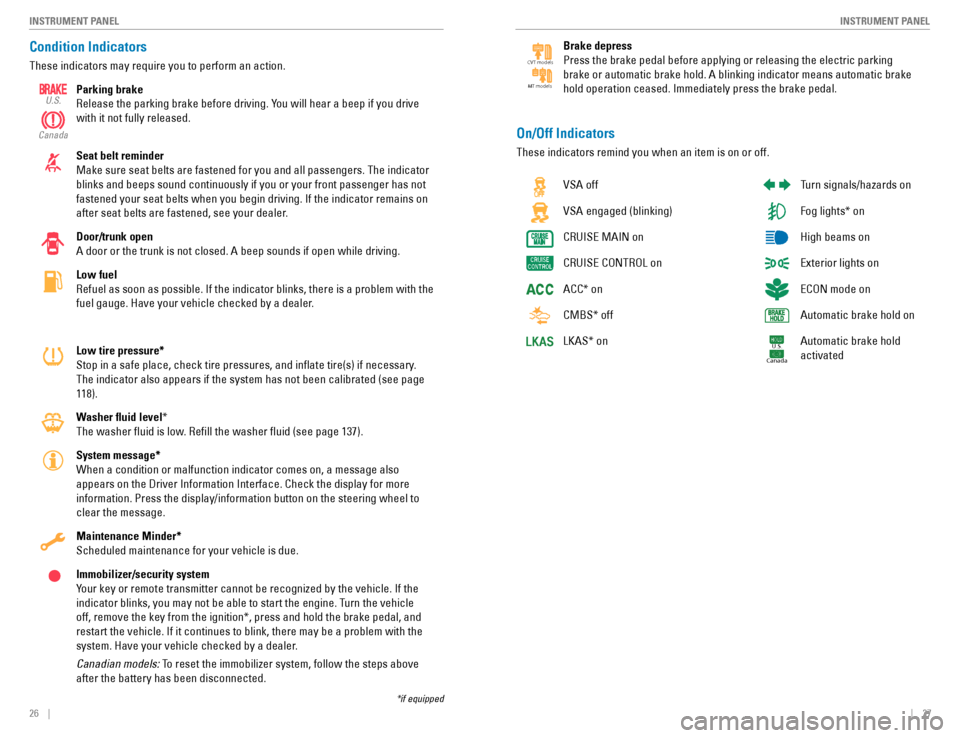
26 || 27
INSTRUMENT PANEL
INSTRUMENT PANEL
Condition Indicators
These indicators may require you to perform an action.
Parking brake
Release the parking brake before driving. You will hear a beep if you drive with it not fully released. Seat belt reminder Make sure seat belts are fastened for you and all passengers. The indicator
blinks and beeps sound continuously if you or your front passenger has not
fastened your seat belts when you begin driving. If the indicator remains on
after seat belts are fastened, see your dealer. Door/trunk open A door or the trunk is not closed. A beep sounds if open while driving. Low fuel
Refuel as soon as possible. If the indicator blinks, there is a problem with the
fuel gauge. Have your vehicle checked by a dealer. Low tire pressure*
Stop in a safe place, check tire pressures, and in�ate tire(s) if necessary. The indicator also appears if the system has not been calibrated (see page 118).
Washer �uid level *
The washer �uid is low. Re�ll the washer �uid (see page 137).System message* When a condition or malfunction indicator comes on, a message also appears on the Driver Information Interface. Check the display for more information. Press the display/information button on the steering wheel to clear the message. Maintenance Minder* Scheduled maintenance for your vehicle is due. Immobilizer/security system
Your key or remote transmitter cannot be recognized by the vehicle. If the
indicator blinks, you may not be able to start the engine. Turn the vehicle off, remove the key from the ignition*, press and hold the brake pedal, and restart the vehicle. If it continues to blink, there may be a problem with the
system. Have your vehicle checked by a dealer. Canadian models: To reset the immobilizer system, follow the steps above
after the battery has been disconnected.
U.S.
Canada
*if equipped VSA off VSA engaged (blinking)CRUISE MAIN onCRUISE CONTROL onACC* onCMBS* offLKAS* on
Turn signals/hazards on Fog lights* onHigh beams onExterior lights onECON mode onAutomatic brake hold onAutomatic brake hold activated
U.S.
Canada
On/Off Indicators
These indicators remind you when an item is on or off.
Brake depress Press the brake pedal before applying or releasing the electric parking
brake or automatic brake hold. A blinking indicator means automatic brake hold operation ceased. Immediately press the brake pedal.
CV
T models
MT models
Page 18 of 82
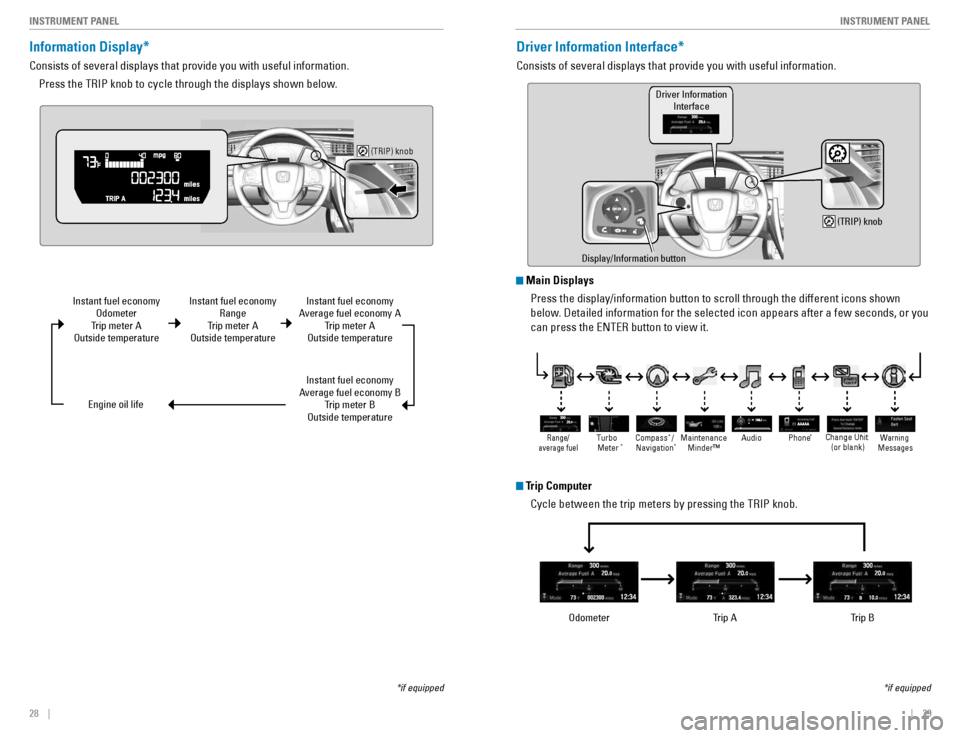
28 || 29
INSTRUMENT PANEL
INSTRUMENT PANEL
Information Display*
Consists of several displays that provide you with useful information.
Press the TRIP knob to cycle through the displays shown below.
(TRIP) knob
Instant fuel economy Odometer
Trip meter A
Outside temperature
Engine oil life
*if equipped
Instant fuel economy Range
Trip meter A
Outside temperature Instant fuel economy
Average fuel economy A Trip meter A
Outside temperature
Instant fuel economy
Average fuel economy B Trip meter B
Outside temperature
Driver Information Interface*
Consists of several displays that provide you with useful information.
*if equipped
Display/Information button
(TRIP) knob
Driver InformationInterface
Odometer Trip A Trip B
Main Displays
Press the display/information button to scroll through the different icons shown
below. Detailed information for the selected icon appears after a few seconds, or you can press the ENTER button to view it.
Trip Computer
Cycle between the trip meters by pressing the TRIP knob.
AAAAA
Warning
Message sChange Unit
(or blank)
Maintenance
Minder™ Phon
e *
Turbo
Meter * Audio
*
Compass / *
Navigation *Range/
average fuel
Page 19 of 82
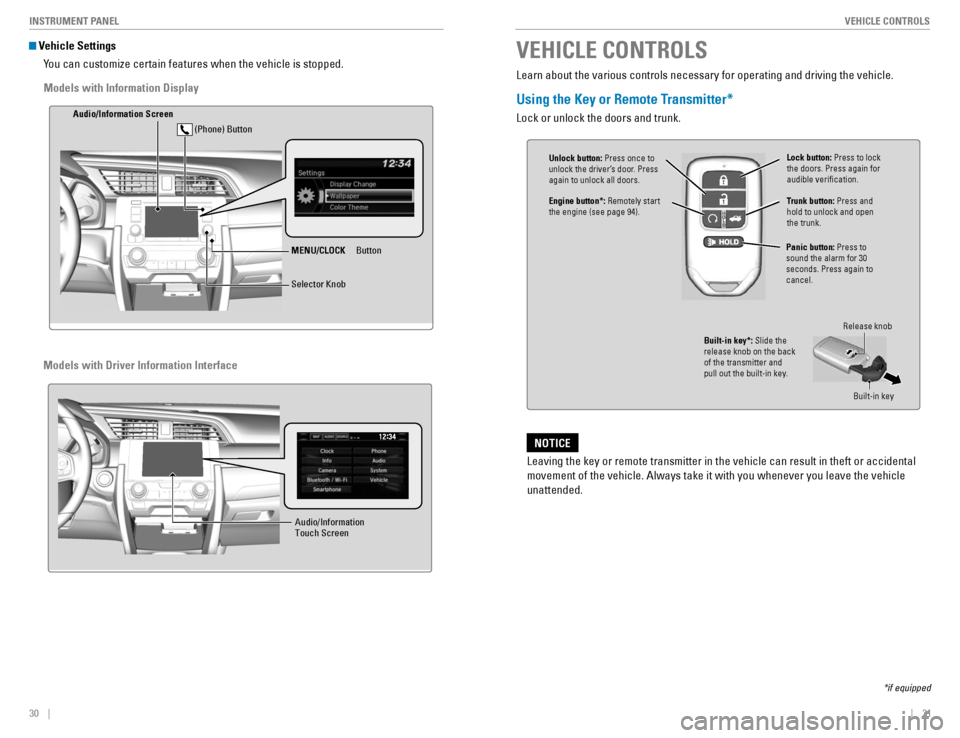
30 || 31
VEHICLE CONTROLS
INSTRUMENT PANEL
Vehicle Settings
You can customize certain features when the vehicle is stopped.
MENU/CLOCK Button
Audio/Info
rmation Screen
Selector Knob
(Phone) Button
Audio/Information Touch Screen
VEHICLE CONTROLS
*if equipped
Learn about the various controls necessary for operating and driving the vehicle.
Using the Key or Remote Transmitter*
Lock or unlock the doors and trunk.
Unlock button:
Press once to
unlock the driver’s door. Press again to unlock all doors.
Trunk button: Press and
hold to unlock and open the trunk.
Lock button: Press to lock
the doors. Press again for audible veri�cation.
Panic button: Press to
sound the alarm for 30 seconds. Press again to cancel.
Built-in key*: Slide the
release knob on the back of the transmitter and
pull out the built-in key.
Release knob
Built-in key
Leaving the key or remote transmitter in the vehicle can result in theft or accidental
movement of the vehicle. Always take it with you whenever you leave the vehicle unattended.
NOTICE
Engine button*: Remotely start
the engine (see page 94).
Models with Information Display
Models with Driver Information Interface
Page 22 of 82
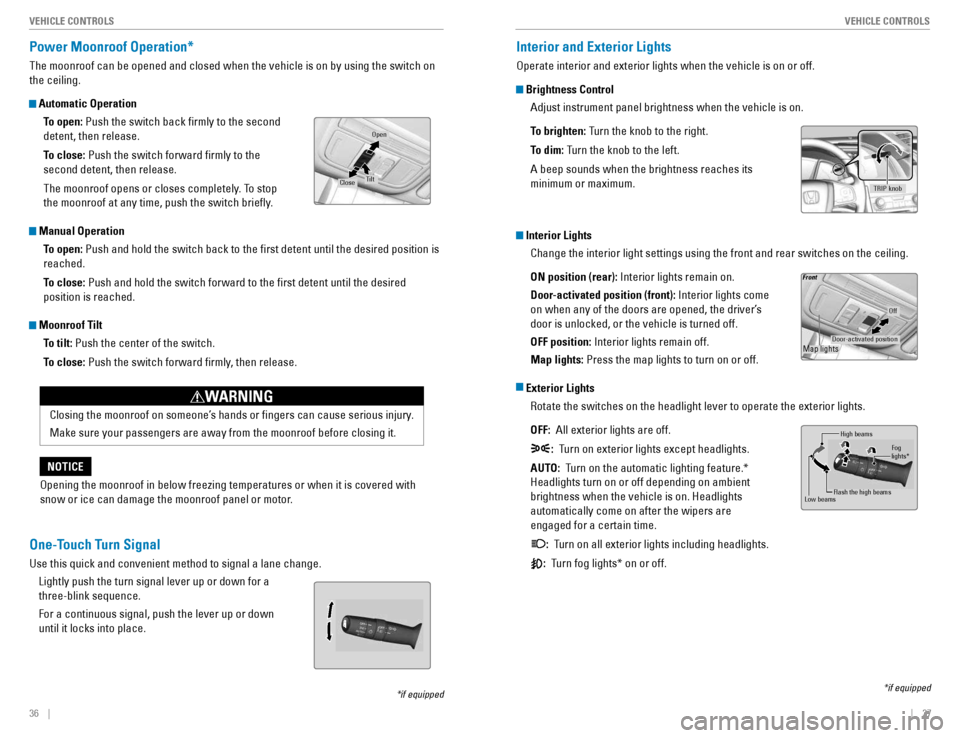
36 || 37
VEHICLE CONTROLS
VEHICLE CONTROLS
Power Moonroof Operation*
The moonroof can be opened and closed when the vehicle is on by using the switch on the ceiling.
Automatic Operation
To open: Push the switch back �rmly to the second
detent, then release.
To close: Push the switch forward �rmly to the
second detent, then release.
The moonroof opens or closes completely. To stop
the moonroof at any time, push the switch brie�y.
Manual Operation
To open: Push and hold the switch back to the �rst detent until the desired position is
reached.
To close: Push and hold the switch forward to the �rst detent until the desired
position is reached.
Moonroof Tilt
To tilt: Push the center of the switch.
To close: Push the switch forward �rmly, then release.
*if equipped
Open
CloseTilt
Opening the moonroof in below freezing temperatures or when it is covered with
snow or ice can damage the moonroof panel or motor.
NOTICE
Closing the moonroof on someone’s hands or �ngers can cause serious injury. Make sure your passengers are away from the moonroof before closing it.
WARNING
Interior and Exterior Lights
Operate interior and exterior lights when the vehicle is on or off.
Brightness Control
Adjust instrument panel brightness when the vehicle is on.
To brighten: Turn the knob to the right.
To dim: Turn the knob to the left.
A beep sounds when the brightness reaches its minimum or maximum.
Interior Lights
Change the interior light settings using the front and rear switches on the ceiling. ON position (rear): Interior lights remain on.
Door-activated position (front): Interior lights come
on when any of the doors are opened, the driver’s door is unlocked, or the vehicle is turned off. OFF position: Interior lights remain off.
Map lights: Press the map lights to turn on or off.
Exterior Lights
Rotate the switches on the headlight lever to operate the exterior lights. OFF: All exterior lights are off.
: Turn on exterior lights except headlights.
AUTO: Turn on the automatic lighting feature.*
Headlights turn on or off depending on ambient brightness when the vehicle is on. Headlights automatically come on after the wipers are engaged for a certain time. : Turn on all exterior lights including headlights.
: Turn fog lights* on or off.
*if equipped
TRIP knob
Door-activated position
Off
Fron t
Map lights
High beams
Flash the high beams
Low beams
Fog lights*
One-Touch Turn Signal
Use this quick and convenient method to signal a lane change.
Lightly push the turn signal lever up or down for a three-blink sequence. For a continuous signal, push the lever up or down until it locks into place.
Page 49 of 82

90 || 91
DRIVING
DRIVING
DRIVING
Learn about preparation for driving, as well as other features.
Before Driving
Check the following items before you begin driving.
Exterior Checks
• Make sure there are no obstructions on the windows, door mirrors, exterior lights,
or other parts of the vehicle.
• Remove any frost, snow, or ice.
• Make sure the hood is securely closed.
• Heat from the engine and exhaust can ignite �ammable materials left under the
hood, causing a �re. If you’ve parked your vehicle for an extended period, inspect and remove any debris that may have collected, such as dried grass and leaves
that have fallen or have been carried in for use as a nest by a small animal. Also
check under the hood for leftover �ammable materials after you or someone else has performed maintenance on your vehicle.
• Make sure the tires are in good condition.
• Make sure there are no people or objects behind or around the vehicle.
If the doors are frozen shut, use warm water around the door edges to melt any ice. Do not try to force them open, as this can damage the rubber trim around the doors. When done, wipe dry to avoid further freezing.
NOTICE
In addition: • During the �rst 600 miles (1,000 km) of operation, avoid sudden acceleration or full
throttle operation so as not to damage the engine or powertrain.
• Avoid hard braking for the �rst 200 miles (300 km). You should also follow this when
the brake pads are replaced.
Improper accessories or modi�cations can affect your vehicle’s handling,
stability, and performance, and cause a crash in which you can be seriously hurt or killed.
Follow all instructions in the vehicle owner’s manual regarding accessories and modi�cations.
WARNING
Interior Checks
• Store or secure all items on board properly.
• Do not place anything in the front-seat footwells. Make sure to secure the �oor
mats.
• If you have any animals on board, do not let them move freely around in the
vehicle.
• Securely close and lock all doors and the trunk.
• Adjust your seating position, mirrors, and steering wheel properly.
• Make sure items placed on the �oor behind the front seats cannot roll under the
seats.
• Everyone in the vehicle must fasten their seat belt.
• Make sure that the indicators in the instrument panel come on when you start the
vehicle, and go off soon after.